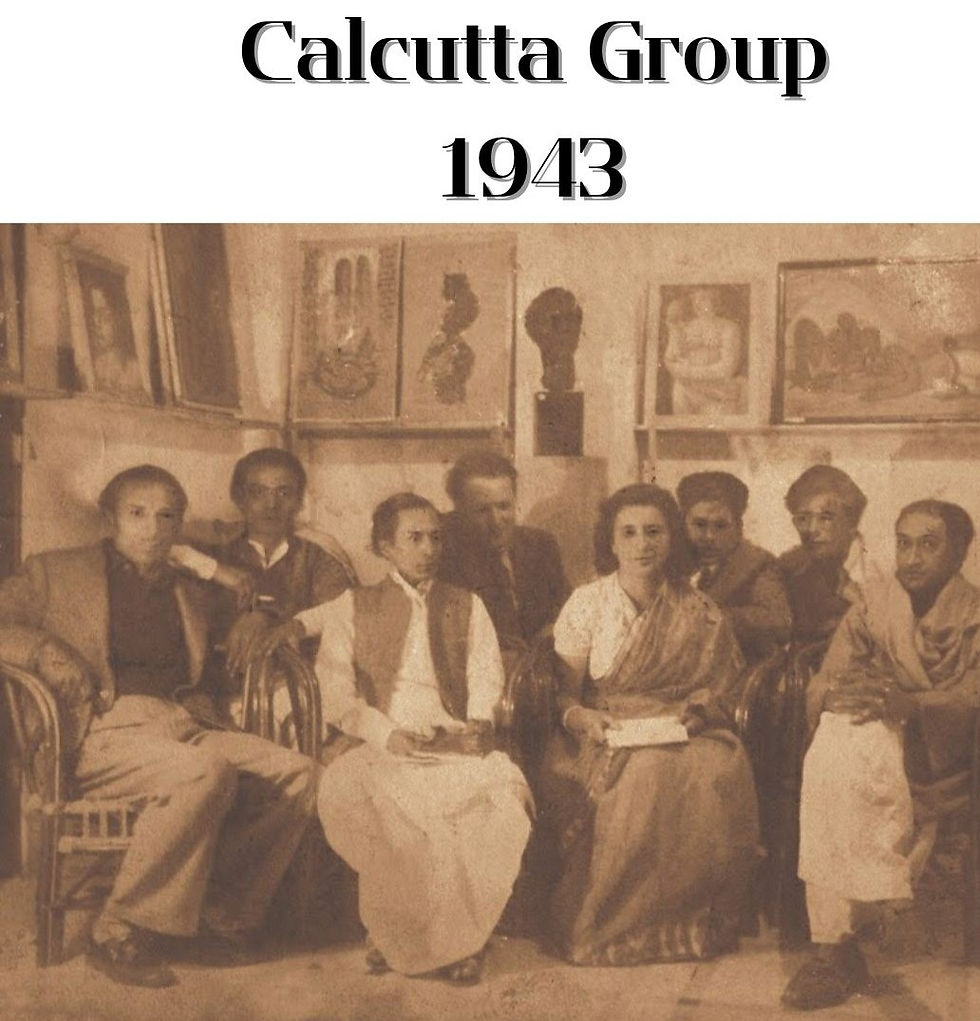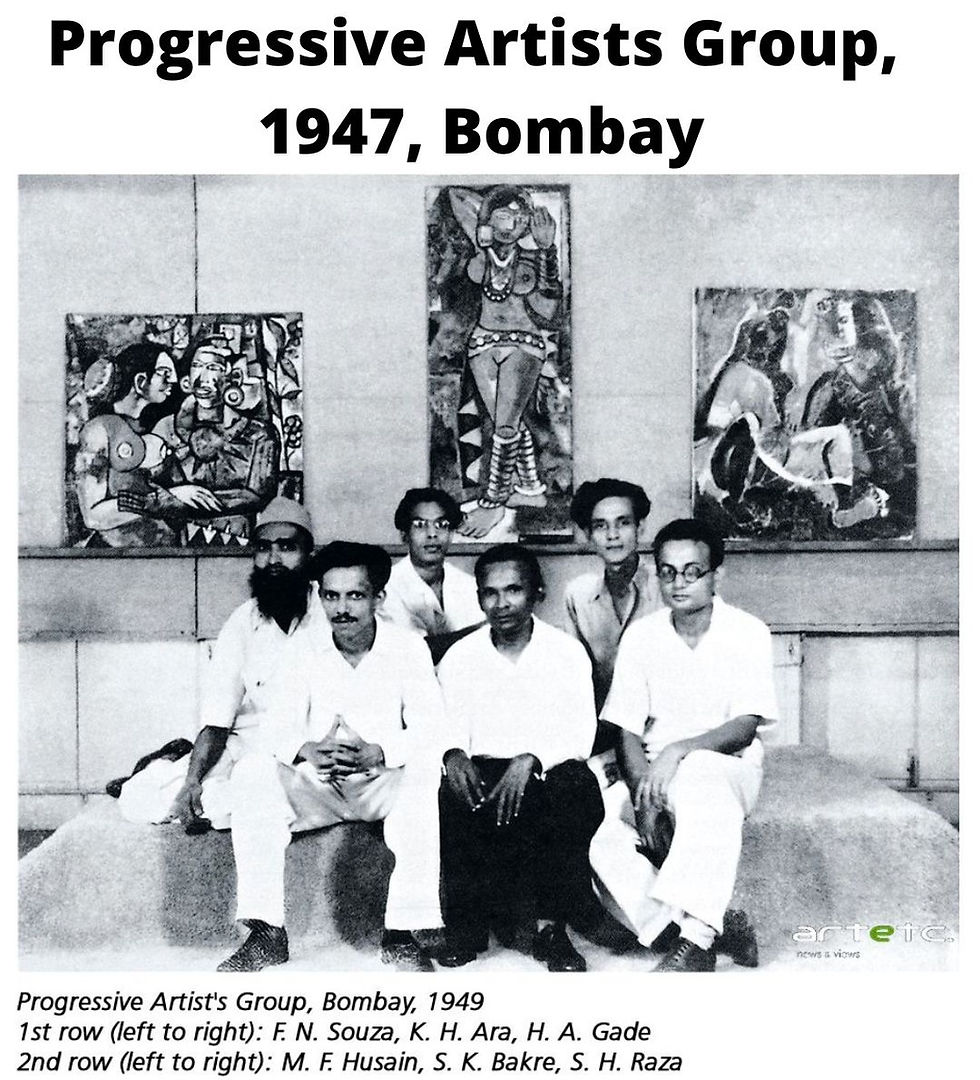Progressive Artists – A Movement that Shaped Indian Modernism
- Admin Artkyk
- Oct 3, 2022
- 4 min read
Updated: Oct 4, 2022
The decade of the 1940’s saw a major shift in the way artists perceived themselves in the evolving socio-political scenario. These artists were questioning their role as artists from India, while simultaneously wanting to go beyond the boundaries and seek the wider heritage of art in the world, especially given the rapid modernisation that was all around them. The questions included that of identity, ‘modern’ art - as opposed to the revivalism of classical art - on one hand, and the academic realism on the other.
This was a time of rebellion, but a constructive one, by the youth. Given the excitement of a country on the verge of Independence, it was the zeitgeist of the times! The formation of the Progressive Writers Association’s (Pragatisheel Lekhak Sangh) conference in 1936, led this thought process. It gained momentum in 1940’s with the formation of the Indian People’s Theatre Association (1941) in Bangalore, which in turn spread across the country.
The idea behind all these groups was to inspire the creative mind and mobilise people through the written word, drama, and art, and build a new world of freedom and social justice. For art - the three distinct metros of India, Kolkata (Calcutta), Mumbai (Bombay) and Chennai (Madras) emerged as the harbingers of change. Interestingly artists came together as a group and chose to be identified as ‘Progressive’ and not Modern.
You might wonder how does the ‘modernism’ aspect tie in with the progressive attitude of the artists? We will be discussing the groups and what each set out to do, but to give a broad view - the identification of these groups as 'Modern' stems from the positioning done in more recent times by the various stakeholders in the art market, especially the auction world. This decade is pegged as ‘Modern’ as it aligns with the European art world categories and it feels appropriate as the artists were variously struggling to find their ‘modern’ voice.
We have read much about the Bombay group, which continues to grab exhibition and auction headlines. Very few know that there were three distinct progressive groups, each weaving into the story of the other, and yet evolving important art languages of their own. So we will start at the beginning of this thought process, and since things must originate somewhere, and like most cultural movements for 20th Century India this one started in Calcutta (now Kolkata).

The motto of the Calcutta Progressive Artist group was "Art should aim to be international and interdependent". In 1942, artists Prodosh Das Gupta, Shubho Tagore, Nirode Mazumdar, Rathin Maitra, Prankrishna Pal, Kamala Dasgupta, Paritosh Sen and Gopal Ghose, united through a liberal worldview - and not (what is often the case in that beehive of a city) political ideology or stylistic language.
This was a direct response to the Bengal Revivalist School (more interesting stories there!) and the turmoil in the country, especially the Bengal famine of the 1940s. This group of young artists were inspired to find their own voice that was strong and decisive, a voice cutting through the upheaval of the prevalent times.
They held exhibitions in Calcutta, beginning in 1944 and went on to exhibit in Bombay in 1944 and 1945. Mulk Raj Anand and Rudi von Leyden applauded their paintings and supported their work. Eventually, the Calcutta Group of Artists would exhibit together with the Bombay Progressives in 1950.
The Calcutta Group officially ceased to exist in 1953, with each artist evolving a distinct independent language.
The idea of a progressive movement for art next spread to the cultural powerhouse of the South of India, Madras (now Chennai), with the establishment of the Progressive Painters Association formed by KCS Panicker in 1944 in Madras.

Some of the core members were P.V. Janakiram, Srinivasulu, L. Munuswamy, A.P. Santhanaraj, Varadarajan, A.S. Jagannathan, S. Dhanapal, M. Senathipathi, K.V. Haridasan, M.V. Devan, amongst others.
Interestingly there is very little information available about the manifesto of this group. However, they followed a direction that was at the end of the spectrum from the Calcutta group, focussing on the local for inspiration.
The Madras Progressive Painters believed that the regional art forms were a 'deathless store of energy’ and turned to finding their roots through local. Their stylistic language, however, was in line with the Calcutta group, i.e., modern, and bold.
The 1940s were a period when young artists across the country were seeking out a new visual language that captured their thoughts and ideas, the change that was sweeping the subcontinent.
What was started in Calcutta, culminated to one of India’s best known and most celebrated cohort of artist gorup - the Progressive Artists Group, Bombay (PAG). Established in 1947, at the dawn of India’s independence, PAG were the most conscious of the other two groups and went on to dominate Indian modernism in the subsequent years.
They had a manifesto; their exhibitions were written about, and they have a much-publicized group photo.
We believe this photograph is telling and needs to be looked at properly, to understand how this was a sea change from the past!

Six young artists look defiantly into the camera, setting the tempo for the group they represent –the progressive artists' group. They look at the viewer directly and self-assuredly. There is power in their gaze; they appear conscious of their identity as artists, who have set out to change the path hitherto. It is this attitude that sets them apart from their contemporaries, and those who came before them. A light-hearted confidence in who they are, and what they are creating.
Look at the photograph again - the gaze of the artists also indicates that they are in turn aware of the gaze of the viewer and are inviting the viewer to be a part of this brave new world.
The informality of their grouping, how they posed – all seated on a low platform rather than chairs - the casualness of their postures, speaks of an easy camaraderie they would have shared.

However casual the photograph may appear, they pose for a picture, aware of the potency of the image, wanting to make a statement. Why do we think this? It appears to us it’s as though they wanted to break the barrier of the formality of art exhibitions. The annual exhibitions of the Bombay art society would have been rife with protocol as it was usually a government official who inaugurated and presided over the affair.
So here was a group of artists who wanted to redefine art and artists in India, and push the limits of what was possible, a reflection of the newly born nation.

Comments